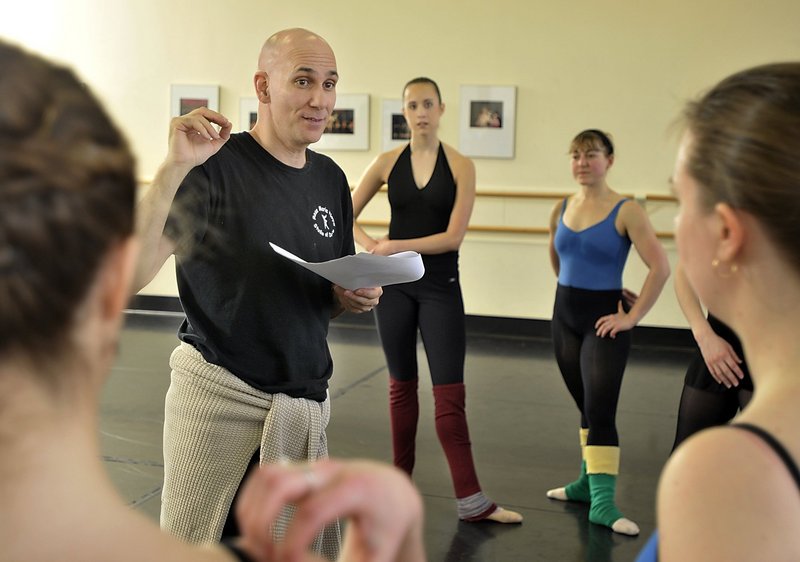PORTLAND — When we hear “Buy Local,” our first thought runs toward the local merchants in the Old Port or across the harbor to Knightville in South Portland — or any other community with an active retail hub.
Why can’t “Buy Local” also extend to our arts communities?
In truth, anybody who buys a ticket to see and hear Mozart’s “Requiem” at Merrill Auditorium Tuesday night is supporting local artists and arts organizations. No, Mozart did not live in Maine, and as far as we know, he didn’t summer in Blue Hill, either.
But the artists performing and interpreting his work are micro-local. The Choral Art Society and Portland Ballet Company tag team for “Requiem.” In addition to the singers and dancers, the production also involves musicians from the Portland Symphony Orchestra.
Almost every person involved in the production — a good 125, give or take — is a local artist who lives and works in the community. They are chorus members, soloists, musicians, dancers and technicians.
“This is as local as it gets,” says Genie O’Brien, Portland Ballet’s artistic director. “This is a celebration of who we are and where we live and the artists who make their living here.”
“Requiem” was the final masterwork of Mozart’s life, written in 1791. It remains one of his most revered compositions and one of the best-loved pieces of music in the classical canon.
“Singers love to sing it. Orchestras love to play it, and audiences love to hear it,” says Robert Russell, music director of the Choral Art Society. “It’s music that we all love, and we sing it almost reflexively.”
On Tuesday, we’ll get a full reading of “Requiem,” along with original choreography by Kennet Oberly, an international choreographer who used to be on the staff at Portland Ballet. The dance that he has set for “Requiem” is entirely original, conceived for Portland Ballet and performed Tuesday for the first time.
The wild card is the dance. Why introduce a new element to a piece of music that is widely loved? Why mess with a masterpiece?
“The answer for me is to get deeper into it and to explore new meanings,” Russell says. “The dance adds an expressive element that no one has ever seen before.”
Oberly came to town in February to set the piece, and has been working closely with rehearsal director Nell Shipman in the weeks since. He returned to Portland last week to see the work through to Tuesday’s premiere.
Oberly has created a contemporary ballet for 12 female dancers that runs the gamut of emotions that are part of Mozart’s composition. The music and text explore the inevitable reality of death, which Mozart faced as he was writing, while offering hope, salvation and rebirth.
This performance is perfectly timed for Easter. As its name implies, the “Requiem” marks the memory of an individual who is passing from the world of the living. His passage is marked by prayers of hope from those he left behind that his soul will make its way to heaven.
Oberly said the challenge of this piece is creating dance movements that fit the music while also respecting Mozart’s complex composition. “Requiem” is many things rolled into one — an opera and a symphony, with a tremendous range of melody and a variety of musical styles.
The dance cannot distract from the majesty of the piece, he said.
Tuesday’s performance marks yet another collaboration between Portland Ballet and the Choral Art Society. They worked together in 2004 and 2007 on “Carmina Burana.”
That partnership was successful and rewarding, so O’Brien and Russell decided to bring their organizations together for another collaboration.
It might be tempting to present a known ballet, and certainly it would require less work and involve fewer uncertainties. But O’Brien said the task of creating something from the ground up inspires the artists and propels them forward in their creative endeavors.
“When I was a dancer, I preferred being fed different things. If I am now in charge of other dancers, this is where your performance values and your skills are enhanced, because it requires such a different sense of giving of yourself,” she said.
“The other work that we do is known. The thrill of doing the unknown is exciting. This will be the world premiere. To totally introduce the world to a new piece is how classics are created.”
In that respect, this is a major piece of work that challenges every member of the organizations involved. The music is hard for singers and musicians alike, and the dancers use just about every ballet skill in their repertoire.
The piece lasts for about an hour. It’s exhausting and exhilarating.
For the singers and musicians, it’s a chance to perform some of the most sacred music ever written. For the dancers, it’s a chance to perform a new ballet for the very first time.
And for the audience, it’s an opportunity to experience the wonder and mystery of live performance.
Whatever happens Tuesday will happen only in that moment, and will uniquely reflect the art and art sensibilities of the artists in our community.
Staff Writer Bob Keyes can be contacted at 791-6457 or at:
bkeyes@pressherald.com
Send questions/comments to the editors.





Comments are no longer available on this story